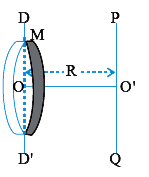Why does a solid sphere have smaller moment of inertia than a hollow cylinder of same mass and radius, about an axis passing through their axes of symmentry ?
To understand why a solid sphere has a smaller moment of inertia than a hollow cylinder of the same mass and radius about an axis passing through their axes of symmetry, we can break down the explanation into several steps.
1. Understanding Moment of Inertia:
- The moment of inertia (I) is a measure of an object's resistance to changes in its rotation. It is defined mathematically as:
I=∫r2dm
where r is the perpendicular distance from the axis of rotation to the mass element dm.
2. Consider the Solid Sphere:
- For a solid sphere of mass M and radius R, we can imagine it as being made up of many infinitesimally small mass elements dm. Each of these mass elements is located at a distance r from the axis of rotation.
- The moment of inertia for the solid sphere can be calculated by integrating over the entire volume of the sphere:
Isphere=∫r2dm
3. Consider the Hollow Cylinder:
- For a hollow cylinder of mass m and radius R, all mass elements are at the same distance R from the axis of rotation.
- The moment of inertia for the hollow cylinder can be expressed as:
Icylinder=mR2
4. Comparing the Two Moments of Inertia:
- The solid sphere has mass distributed throughout its volume, meaning that not all mass elements are at the maximum distance R from the axis. Some mass elements are closer to the axis, which reduces the overall moment of inertia.
- In contrast, the hollow cylinder has all its mass at the maximum distance R from the axis, leading to a larger moment of inertia.
5. Conclusion:
- Since the solid sphere has mass elements that are distributed at varying distances from the axis (some closer than R), its moment of inertia is less than that of the hollow cylinder, which has all its mass at the maximum distance. Therefore, we conclude:
Isphere<Icylinder
- The moment of inertia (I) is a measure of an object's resistance to changes in its rotation. It is defined mathematically as:
I=∫r2dm
where r is the perpendicular distance from the axis of rotation to the mass element dm.
- For a solid sphere of mass M and radius R, we can imagine it as being made up of many infinitesimally small mass elements dm. Each of these mass elements is located at a distance r from the axis of rotation.
- The moment of inertia for the solid sphere can be calculated by integrating over the entire volume of the sphere:
Isphere=∫r2dm
- For a hollow cylinder of mass m and radius R, all mass elements are at the same distance R from the axis of rotation.
- The moment of inertia for the hollow cylinder can be expressed as:
Icylinder=mR2
- The solid sphere has mass distributed throughout its volume, meaning that not all mass elements are at the maximum distance R from the axis. Some mass elements are closer to the axis, which reduces the overall moment of inertia.
- In contrast, the hollow cylinder has all its mass at the maximum distance R from the axis, leading to a larger moment of inertia.
- Since the solid sphere has mass elements that are distributed at varying distances from the axis (some closer than R), its moment of inertia is less than that of the hollow cylinder, which has all its mass at the maximum distance. Therefore, we conclude:
Isphere<Icylinder
Topper's Solved these Questions
- SYSTEM OF PARTICLES AND ROTATIONAL MOTION BOOK - NCERT EXEMPLAR ENGLISHCHAPTER - SYSTEM OF PARTICLES AND ROTATIONAL MOTION EXERCISE - Long answer type questions
12 Videos
- SYSTEM OF PARTICLES AND ROTATIONAL MOTION BOOK - NCERT EXEMPLAR ENGLISHCHAPTER - SYSTEM OF PARTICLES AND ROTATIONAL MOTION EXERCISE - Long answer type questions
12 Videos
- OSCILLATIONSBOOK - NCERT EXEMPLAR ENGLISHCHAPTER - OSCILLATIONSEXERCISE - All Questions
36 Videos
- THERMAL PROPERTIES OF MATTERBOOK - NCERT EXEMPLAR ENGLISHCHAPTER - THERMAL PROPERTIES OF MATTEREXERCISE - Very short Answer type Questions
15 Videos
Similar Questions
why does a soild sphere have smaller moment od inertia than a hollow cylinder of same mass and radius , about an axis passing through their axes of symmetry ?
View SolutionMoment of inertia of a ring of mass M and radius R about an axis passing through the centre and perpendicular to the plane is
View SolutionThe moment of inertia of a cube of mass M and edge length a about an axis passing through one of its edge is
View SolutionThe moment of inertia of a hollow cubical box of mass M and side a about an axis passing through the centres of two opposite faces is equal to.
View SolutionThe moment of inertia of a cylinder of mass 1000gm and radius 20cm about the axis AB shown in figure is

View SolutionThe moment of inertia of a ring of mass M and radius R about PQ axis will be

View SolutionCalculate the moment of inertia of a ring of mass 2kg and radius 2cm about an axis passing through its centre and perpendicular to its surface.
View SolutionCalculate the moment of inertia of a ring of mass 2kg and radius 2cm about an axis passing through its centre and perpendicular to its surface.
View SolutionThe moment of inertia of a spherical shell and a hemispherical shell of same mass and radius about a tangential axis, passing through P will be

View SolutionUsing the formula for the moment of inertia of a uniform sphere, find the moment of inertia of a thin spherical layer of mass m and radius R relative to the axis passing through its centre.
View Solution
